The year 2025 is set to mark a pivotal era for Artificial Intelligence (AI) and Machine Learning (ML), ushering in advancements that could transform industries, reshape societies, and redefine daily life. As we approach this technological turning point, AI is rapidly evolving – not just in its capabilities but in how deeply it integrates into our everyday existence, from the routine to the revolutionary.
We outline 15 predictions for the future of AI and ML by 2025, drawing from current trends, expert perspectives, and vibrant discussions on platforms like X. Envision a world where AI agents become as common as smartphones, drive groundbreaking scientific discoveries, and ignite public reactions on an extraordinary scale.
These predictions paint a picture of a future where AI holds immense potential, balancing innovation with complex challenges. They invite us to reflect on not just the technological progress but also the profound ethical, social, and economic changes that will inevitably follow.
Table of Contents
1. AI Agents Becoming Mainstream
By 2025, AI agents are set to become integral parts of everyday life, performing an array of tasks from managing personal finances to handling daily chores. These AI entities, often referred to as “digital workers,” will execute tasks autonomously or with minimal human oversight, leveraging advancements in machine learning, natural language processing, and predictive analytics.
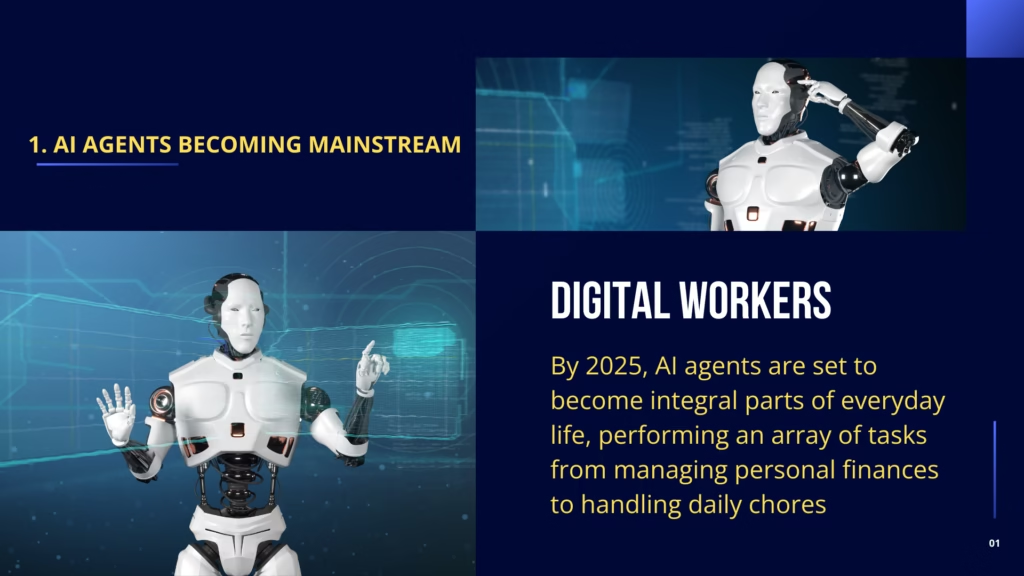
Personalization and Efficiency
AI agents will offer unprecedented levels of personalization, adapting to individual user preferences and behaviors over time. For instance, financial AI agents could manage investments by learning from your risk profile and past decisions, potentially optimizing returns more effectively than traditional methods. Similarly, home automation agents could learn your routines, adjusting everything from lighting to heating based on your habits, thereby enhancing efficiency and comfort.
Business Applications
In the business sector, AI agents will revolutionize workflow automation. They will handle tasks like scheduling, customer service, and even complex decision-making processes by integrating into existing corporate systems. Salesforce, for example, has already introduced ‘Agentforce,’ a platform that allows businesses to create AI agents tailored to specific tasks, indicating a trend that’s expected to expand significantly by 2025.
Market Expansion
The global AI agent market is set to grow, with projections suggesting a market size of $47.1 billion by 2030, indicating a steep rise from 2024’s $5.1 billion. This growth is driven by the demand for automation in small to large enterprises where custom AI solutions can be developed without extensive in-house capabilities.
Ethical and Privacy Considerations
With this mainstream adoption comes the challenge of ensuring privacy and ethical use. As AI agents manage more personal data, there will be a push for stronger data protection laws and ethical AI practices to prevent misuse or breaches.
This transformation towards mainstream AI agents will redefine personal and professional life, making them essential tools for enhancing productivity, decision-making, and personal convenience by 2025.
2. Multi-Modal AI Mastery
By 2025, the field of AI is expected to see a significant leap in multi-modal capabilities, where AI systems can seamlessly integrate and process multiple types of data — including text, images, audio, and video — to provide more holistic and nuanced outcomes. This evolution will dramatically enhance the functionality and application of AI across various sectors.
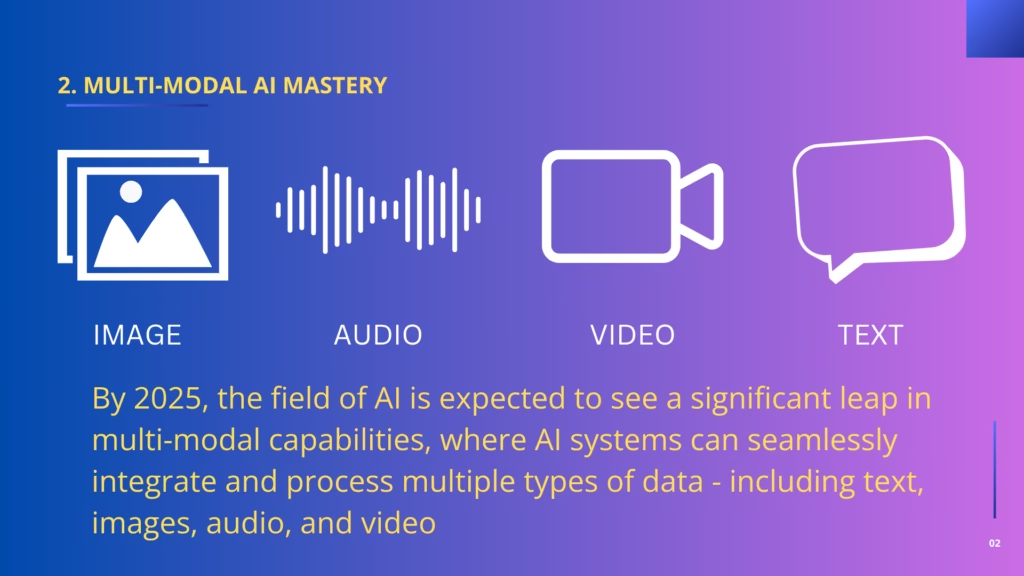
Enhanced User Interaction
Multi-modal AI will lead to more intuitive user interfaces. For instance, a smart home system could interpret both your spoken commands and the visual context of your environment, like recognizing that you’re looking at a light switch when you say “turn this off,” thereby enhancing user experience with minimal effort. This could also extend to virtual and augmented reality, where AI interprets hand gestures, voice commands, and visual cues to create more immersive experiences.
Healthcare and Diagnostics
In healthcare, multi-modal AI could combine different diagnostic data types for more accurate diagnoses. A system might analyze an MRI scan alongside a patient’s medical history, symptoms described in text or voice, and even genetic data to provide a comprehensive view of a patient’s health, potentially leading to earlier and more precise interventions.
Education and Training
Education will benefit from AI that can process both visual and auditory inputs. This could mean personalized learning where AI assesses a student’s understanding through voice, written responses, and facial expressions during online classes, adapting teaching methods in real-time to suit each learner’s pace and style.
Marketing and Content Creation
Marketing will see a revolution with AI that can analyze consumer sentiment through various channels. By understanding visual content, customer reviews in text, and tone in voice feedback, companies can craft highly targeted marketing strategies. In content creation, AI could generate dynamic content that matches the context of images, videos, or live streams, making advertising more effective and engaging.
Technical Challenges
Achieving this level of multi-modality involves overcoming significant technical hurdles. Data fusion, where different modalities are aligned and processed together, requires advanced algorithms to ensure coherence and accuracy. Companies like Google, with its Gemini model, and Meta, with ImageBind, are already pushing these boundaries, but full integration across all modalities at scale remains a complex challenge.
Ethical Considerations
With the ability to process multiple data types comes increased responsibility regarding privacy and consent. There’s a risk of misuse, where AI could infer too much from combined data streams, potentially leading to privacy invasions or biased decision-making if not carefully managed.
By 2025, multi-modal AI mastery will likely transform how we interact with technology, making it more intuitive and context-aware. However, this advancement will also necessitate new standards for data protection, ethical AI use, and perhaps even new regulatory frameworks to manage the implications of such powerful technology.
3. Advancements in AI Reasoning
By 2025, AI systems are anticipated to exhibit significantly enhanced reasoning capabilities, moving beyond simple pattern recognition to more complex forms of logical thinking, problem-solving, and decision-making. This evolution will make AI not just tools for data processing but partners in strategic and creative endeavors.
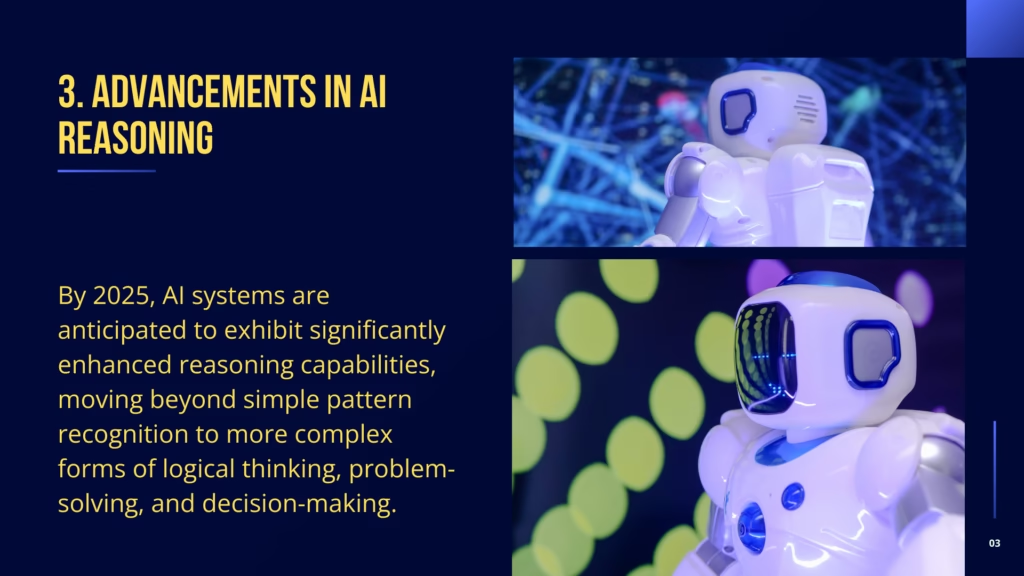
Logical Reasoning
AI will be capable of understanding and applying logical principles, similar to human reasoning. This includes the ability to make inferences, solve puzzles, or navigate through complex scenarios where the rules are not explicitly stated. Such systems could, for instance, interpret legal texts to assist in legal analysis, predicting outcomes based on precedents and statutes.
Decision Making Under Uncertainty
AI will excel in environments characterized by uncertainty, where it can weigh possibilities and probabilities much like a human expert would. In healthcare, AI could recommend treatments by considering a patient’s unique medical history, current symptoms, and the probabilistic outcomes of different interventions, all while adapting to new medical research or data.
Causal Inference
Understanding causality rather than just correlation will be a key advancement. AI systems will be better equipped to discern cause and effect, allowing for more precise interventions in fields like climate science, where understanding the impact of various factors on climate change is crucial for effective policy-making.
Strategic Planning
AI will assist in strategic planning across industries, from military applications where it can simulate outcomes of various tactical decisions to business, where it can forecast market changes or optimize logistics. For example, in supply chain management, AI could predict disruptions and suggest rerouting or alternative sourcing strategies.
Integration with Knowledge Graphs
AI’s reasoning capabilities will be bolstered by the use of knowledge graphs, which provide structured and contextual data. This integration will allow AI to “understand” relationships between concepts, enhancing its ability to reason about new information based on existing knowledge.
Challenges and Ethical Considerations
With enhanced reasoning comes the challenge of ensuring AI decisions are explainable and fair. The “black box” nature of some AI systems might give way to more transparent models, but this transition is not without hurdles. Ethical reasoning will also be crucial; AI must be programmed to consider moral and ethical implications of its decisions, particularly in sensitive areas like autonomous vehicles or judicial systems.
Impact on Jobs
While AI with advanced reasoning could displace certain jobs, it also opens up new roles, particularly in AI oversight, ethics, and integration specialists who ensure AI decisions align with human values and organizational goals.
Research and Development
Numerous research groups and companies are already pushing the boundaries of AI reasoning. Institutions like MIT, Stanford, and companies like DeepMind and IBM are working on projects that blend traditional AI with symbolic AI to achieve more robust reasoning capabilities.
By 2025, the landscape of AI will be marked by systems that not only analyze data but also reason about it in ways that are currently more aligned with human cognitive processes. This will not only increase the efficiency and accuracy of AI applications but also expand the scope of tasks AI can perform, reshaping industries and challenging our understanding of what AI can achieve.
4. Humanoid Robots in Everyday Life
By 2025, the integration of humanoid robots into everyday life is expected to see significant advancements, transitioning from niche applications to more widespread use in both domestic and commercial settings. These robots will not only become more capable but also more affordable and accessible, fundamentally changing how we live, work, and interact.
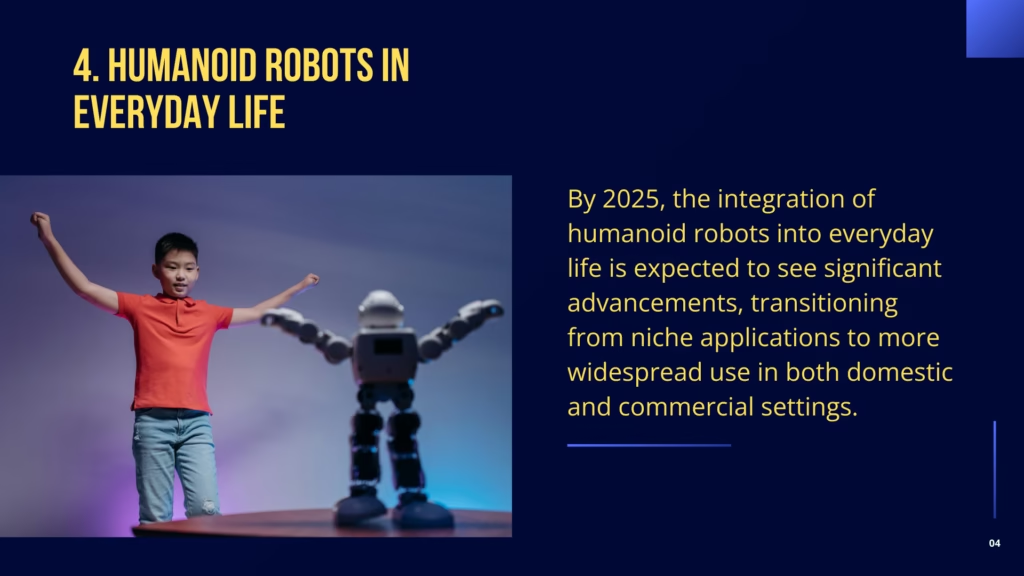
Design and Functionality
Humanoid robots will evolve to match human movements more accurately, thanks to improvements in materials science, sensor technology, and AI algorithms for motion control. Robots like Boston Dynamics’ Atlas or SoftBank Robotics’ Pepper are already showing capabilities in mobility and interaction, and by 2025, these features will be standard, allowing robots to perform tasks like cleaning, serving, or even assisting in simple repair jobs.
Domestic Use
In homes, these robots will manage chores such as cleaning, cooking basic meals, or aiding the elderly and disabled. Their ability to navigate complex environments like homes with stairs or cluttered spaces will be significantly enhanced. Companies like iRobot, known for the Roomba, are anticipated to introduce more sophisticated models that might include humanoid features for more interactive assistance.
Commercial Applications
In commerce, humanoid robots will serve customers in retail environments, from guiding shoppers to handling transactions or even working alongside human staff in restaurants or hotels. They could also play roles in entertainment, providing interactive experiences or performing in shows.
Health and Elder Care
One of the most impactful areas will likely be healthcare and elder care, where robots can offer companionship, monitor health metrics, remind about medication, or assist with mobility. This could help manage the growing demand for elderly care, especially in societies with aging populations like Japan, where robots like Robear are already in development.
Education
In educational settings, humanoid robots could act as teaching assistants, particularly in special education or for interactive learning experiences that adapt to each student’s pace and style. They could also serve in language teaching by mimicking native speakers’ mannerisms and intonations.
Ethical and Social Integration
The broader adoption of humanoid robots will raise ethical questions about labor, privacy, and human-robot interaction. How society integrates these robots will depend on addressing concerns about job displacement, the psychological impact of living with robots, and ensuring they respect privacy and personal space.
Regulatory Framework
With robots becoming more ubiquitous, there will be a push for new regulations regarding their operation, safety, and rights, especially in scenarios where robots interact closely with humans. This might include laws on robot accountability, data security, and ethical programming to prevent misuse.
Technological Barriers
Despite the optimism, there are still technological challenges, including battery life, the cost of sophisticated robotics, and the need for continuous AI learning to handle the unpredictability of human environments. Overcoming these will be crucial for the widespread adoption of humanoid robots.
Market Growth
The market for service robots, including humanoid types, is projected to grow significantly, with some estimates suggesting a market size of over $25 billion by 2025, driven by both consumer demand and commercial applications.
By 2025, humanoid robots are poised to become more than just novelties or industrial tools; they will be integrated into the fabric of daily life, offering assistance, companionship, and opening new avenues for human engagement with technology. However, this integration must be managed carefully to balance technological benefits with social, ethical, and economic impacts.
5. AI in Scientific Discovery
By 2025, artificial intelligence is expected to revolutionize scientific discovery across multiple disciplines, becoming an indispensable tool for researchers and potentially accelerating the pace of breakthroughs in fields ranging from medicine to environmental science.
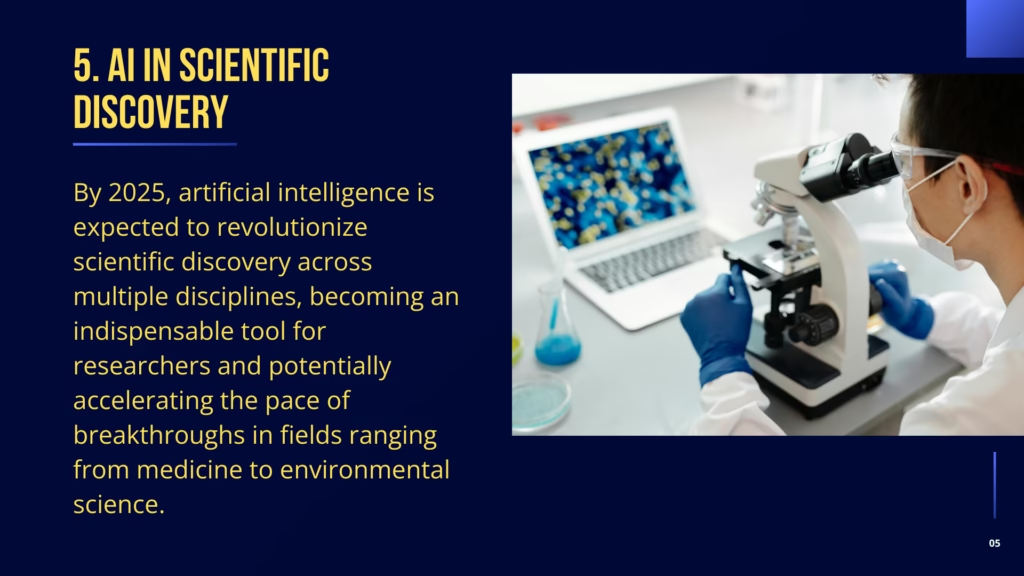
Drug Discovery
AI will significantly speed up the drug discovery process by predicting how different compounds interact with biological targets. Platforms like DeepMind’s AlphaFold have already demonstrated the power of AI in predicting protein structures, which is crucial for drug design. By 2025, AI might further streamline drug trials through simulations, reducing the time and cost from discovery to market. Companies like Insilico Medicine are at the forefront, using AI to design drugs against aging and diseases like cancer.
Genomics
In genomics, AI will assist in analyzing vast datasets to identify genetic markers for diseases, predict genetic outcomes, or customize medical treatments based on individual genetic profiles. This could lead to more personalized medicine, where treatments are tailored to the genetic makeup of each patient.
Materials Science
AI will play a pivotal role in predicting new materials with desired properties, aiding in the design of everything from more efficient solar panels to stronger, lighter alloys for aerospace. The Materials Project, backed by the U.S. Department of Energy, uses AI to accelerate materials discovery, and this approach will likely become more sophisticated and widespread.
Environmental Science
AI’s predictive models will enhance our understanding of complex environmental systems, from climate change to biodiversity. It could forecast natural disasters with greater accuracy, model the impact of climate policies, or even help in tracking and managing invasive species or pollutants. Projects like Google’s partnership with NOAA for weather predictions are examples of AI’s growing role in this field.
Astronomy
In astronomy, AI will help sift through the terabytes of data from telescopes to detect phenomena like new exoplanets, supernovae, or dark matter signatures that would be nearly impossible to find manually. The Zwicky Transient Facility uses machine learning to identify cosmic events in real-time, showcasing AI’s potential in this area.
Collaborative Research
AI will not replace scientists but will work alongside them, enhancing human capabilities. AI can propose hypotheses based on data patterns, which human researchers can then test. This symbiosis could lead to a new era of scientific collaboration where AI not only processes data but also contributes to the ideation phase of research.
Ethical and Methodological Challenges
With AI’s integration into scientific research comes the challenge of ensuring data integrity, reproducibility, and avoiding biases that AI might inherit from training data. Ethical considerations, like the ownership of AI-generated discoveries, will also need addressing.
Education and Training
The scientific community will need to adapt, integrating AI literacy into education. Future scientists will need to understand how to work with AI tools, interpret AI-driven results, and critically assess AI’s suggestions.
Funding and Investment:
Governments and private sectors are likely to increase investments in AI for science, recognizing its potential to solve some of the world’s biggest challenges. The U.S. National Science Foundation, for example, has initiatives for AI in science, indicating a trend that will likely expand.
By 2025, AI’s role in scientific discovery will be transformative, not just by speeding up processes but by enabling new methods of inquiry and solving problems at scales or complexities previously unimaginable. This partnership between AI and human ingenuity could usher in an age of accelerated scientific advancement, provided the ethical and practical challenges are navigated thoughtfully.
6. Natural Language Interfaces
By 2025, natural language interfaces (NLIs) will become the standard way for users to interact with technology, significantly simplifying the user experience across applications, from data analysis to everyday device control. This evolution will make technology more accessible, intuitive, and user-friendly.
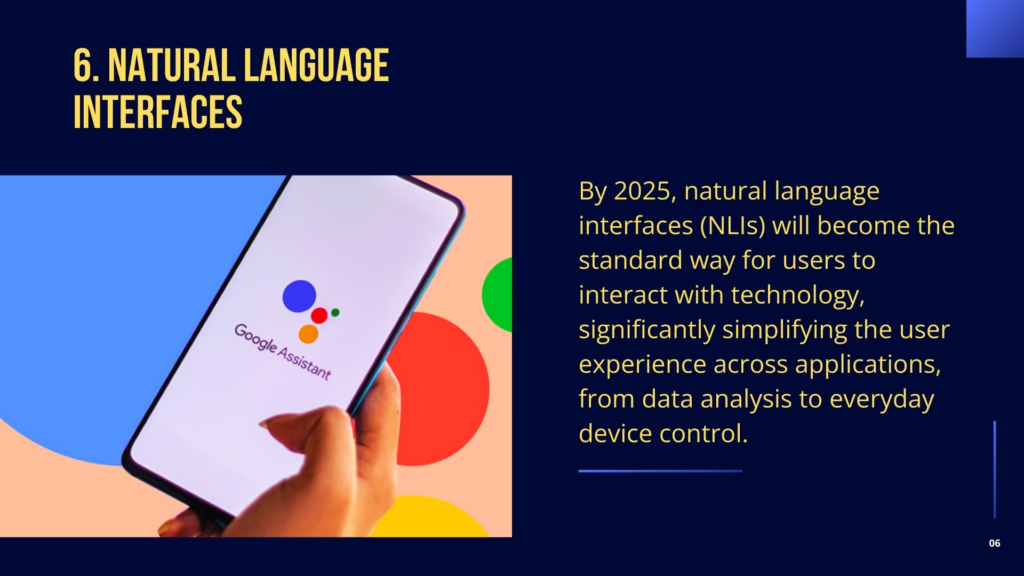
Democratization of Data Analysis
NLIs will allow users to query databases, analyze trends, and gain insights without needing to understand SQL or other programming languages. Tools like IBM Watson or Google Cloud’s Natural Language API are already pushing this envelope, but by 2025, this capability will be widespread. Analysts, business users, or even consumers could ask complex questions about data in plain language, like “Show me sales trends for the last quarter by region,” and receive immediate, understandable responses.
Enhanced User Experience
In consumer tech, from smartphones to home automation systems, NLIs will make interaction more seamless. Voice assistants like Amazon’s Alexa and Google Assistant will evolve, understanding context better, handling more complex queries, and integrating more naturally into daily routines. This will extend to vehicles, where drivers can manage navigation, entertainment, or vehicle settings through conversation.
Education and Learning
In educational settings, NLIs could revolutionize how students learn by allowing them to interact with educational content through natural language. This could mean asking a virtual tutor for explanations on complex topics or querying a digital library for specific information in a conversational manner, making learning more interactive and tailored to individual understanding.
Customer Service
Businesses will leverage NLIs for customer service, where AI chatbots or voice agents will handle inquiries with a level of sophistication that mimics human interaction. This not only improves customer experience but also cuts down on the need for human intervention in routine queries, allowing service teams to focus on more complex issues.
Accessibility
For individuals with disabilities, NLIs will be a game-changer, providing an easier way to interact with technology without physical input. This inclusivity will make digital content and services more accessible to those with motor, visual, or cognitive impairments.
Software Development
Developers will benefit from NLIs through tools that can translate natural language into code, helping to prototype or debug applications quickly. GitHub’s Copilot is an early example of this trend, with more advanced versions expected by 2025 that could handle entire development tasks based on natural language descriptions.
Challenges
Despite the advancements, several challenges remain, including ensuring privacy (as these systems often require listening capabilities), dealing with the nuances of human language (like sarcasm or regional dialects), and maintaining security to prevent misuse or hacking through voice commands.
Ethical Use
There’s also the matter of ethical use, where the data gathered through NLIs must be handled with care to prevent biases or privacy invasions. Companies will need to be transparent about how data from these interactions is used or stored.
Market Growth
The market for natural language processing, a key technology behind NLIs, is expected to grow significantly. Gartner predicts that by 2025, 75% of enterprise applications will feature conversational interfaces, up from less than 10% in 2020.
By 2025, natural language interfaces will not just be an optional feature but a fundamental component of technology interaction, making technology more approachable and human-centered. This shift will require new standards in user interface design, data protection, and perhaps even in how we conceptualize and teach computing skills, as interaction with machines becomes increasingly conversation-based.
7. Agentic AI Breakthroughs
By 2025, we’re poised to witness a significant leap in the capabilities of agentic AI, leading to a transformative moment similar to the release of ChatGPT, where AI agents become indispensable, proactive assistants in both personal and professional environments.
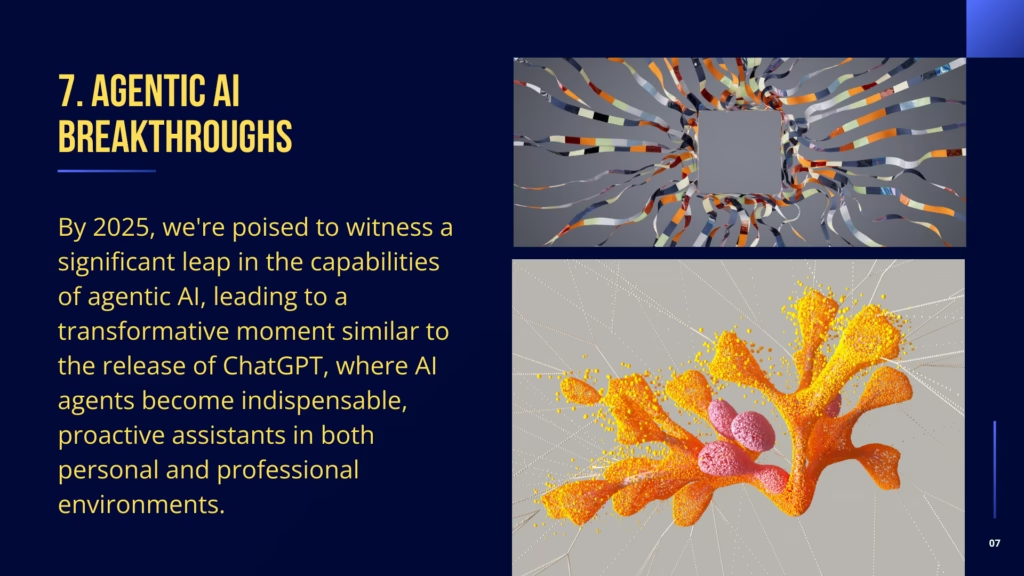
Defining Agentic AI
Agentic AI refers to artificial intelligence systems that can act autonomously on behalf of users, making decisions based on goals, context, and previous interactions. These agents are not just reactive; they predict needs, execute tasks, and learn from their environment to improve over time.
Personal Assistants
The next generation of AI personal assistants will be markedly more sophisticated than current models. They’ll handle complex tasks like managing your entire calendar based on learned preferences, anticipating needs before they arise (like ordering groceries when supplies run low), or even negotiating services or purchases on your behalf. Imagine an AI that not only sets a reminder for your doctor’s appointment but also books it, checks if there are any traffic alerts, and suggests the best time to leave.
Business Automation
In the workplace, agentic AI will automate intricate processes that previously required human oversight. These could range from customer service bots that handle complaints or inquiries with human-like empathy and problem-solving capabilities to AI agents in HR that manage onboarding, scheduling interviews, and even offering preliminary feedback on resumes.
Health and Wellness
In healthcare, agentic AI could manage patient care plans, reminding patients of medication times, monitoring health data for anomalies, or even suggesting lifestyle adjustments based on real-time health metrics. This proactive approach could significantly improve patient outcomes and reduce the workload on healthcare providers.
Financial Management
AI agents will revolutionize personal finance by not just tracking expenses but also advising on investments, adjusting budgets in real-time based on income changes, and even executing trades or optimizing tax strategies, acting much like a personal financial advisor.
Breakthrough Product
One prediction is the emergence of a breakthrough AI agent product that could be as defining for AI as the iPhone was for smartphones. This agent might integrate with all aspects of a user’s digital life, providing a seamless experience across devices and services, with capabilities to learn and adapt in ways that feel eerily human.
Privacy and Security
As these agents become more integrated into daily life, ensuring privacy and security will be paramount. There will be a demand for transparent algorithms where users can understand how their data is used and how decisions are made by AI agents. Security measures will also evolve to protect against unauthorized access or manipulation of these personal AI agents.
Ethical Considerations
The autonomy of these agents will raise ethical questions about accountability, consent, and the extent to which AI should make decisions for humans. Regulatory frameworks might emerge to define the boundaries of AI’s decision-making authority.
Market Impact
The market for agentic AI will expand, with companies like Microsoft, Google, and new startups racing to offer the most intuitive, helpful AI agents. The success of such an AI could significantly shift market dynamics, much like how ChatGPT has influenced the tech and education sectors.
By 2025, agentic AI could redefine productivity, convenience, and personalization in technology, making AI not just a tool but a partner in daily life. This shift will challenge companies to innovate in AI ethics, user interface design, and data protection, all while consumers learn to trust and interact with AI in new, more integrated ways.
8. Proliferation of Personal AI Robots
By 2025, we anticipate a significant increase in the adoption of personal AI robots, transforming how individuals interact with technology in their daily lives. This growth will be driven by advancements in AI, robotics, and a decrease in production costs, making these devices more accessible to the general public.
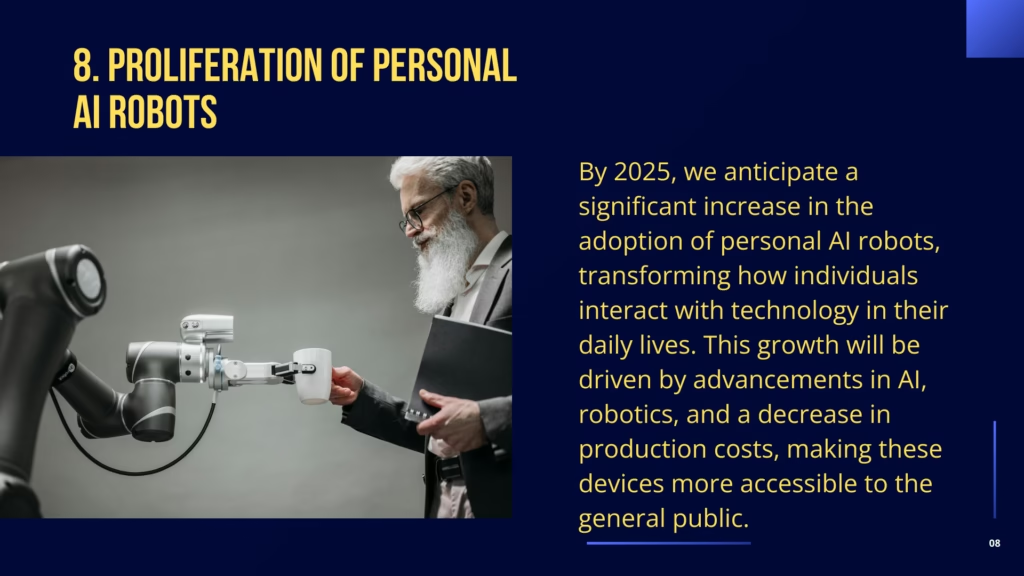
Market Expansion
Estimates suggest that by 2025, sales of personal AI robots could exceed 100,000 units, indicating a burgeoning market for home robotics. Companies like iRobot, which have already made inroads with robotic vacuums, are expected to introduce more advanced models with AI capabilities for various household tasks.
Functionality and Use Cases
- Companionship:
Robots like Jibo or the more advanced iterations of Pepper by SoftBank Robotics will offer emotional support, engage in conversation, and even entertain through games or storytelling. This could be particularly beneficial for the elderly or those living alone, combating loneliness. - Household Chores:
Beyond cleaning, these robots might take on cooking assistance (like suggesting recipes or preparing simple meals), laundry sorting, or even minor home maintenance tasks. - Education and Learning:
AI robots could become educational tools, teaching children through interactive and engaging methods, adapting to their learning pace and style. - Health Monitoring:
Equipped with sensors, these robots can monitor health signs, remind about medication, or assist with physical therapy exercises for those with mobility issues.
Technological Advancements
The integration of more sophisticated AI will enable these robots to learn from their environment, adapt to user behavior, and improve their functionality over time. Improved battery life, sensor technology for better navigation and safety, and natural language processing for more human-like interactions will make these robots more practical and appealing.
Personalization
AI robots will tailor their services to individual users, learning preferences, routines, and even emotional states. This personalization will make each robot a unique companion, enhancing its utility and integration into daily life.
Privacy and Security
With robots becoming more integrated into personal spaces, concerns about data privacy will escalate. There will be a push for secure systems that protect personal information while ensuring the robots themselves are not vulnerable to hacking.
Cost Reduction
As technology matures, the cost of producing these robots will decrease, making them affordable to a broader segment of the population. Economies of scale, along with cheaper sensors and processors, will drive this trend.
Societal Impact
The proliferation of personal AI robots could lead to a shift in societal norms around technology in the home. However, it also raises questions about employment, as robots take over roles traditionally performed by human labor. There will be a need for new kinds of jobs, perhaps in robot maintenance, programming, or AI ethics.
Cultural Adaptation
Different cultures might adopt these robots in varied ways, with some societies more open to having robots as part of daily life than others. This could lead to unique applications or features tailored to cultural contexts.
Regulation and Ethics
By 2025, we might see the beginnings of regulatory frameworks specifically for personal AI robots, addressing issues like safety standards, data usage, and ethical considerations in robot design and interaction.
The rise of personal AI robots by 2025 will not only be a testament to technological innovation but also a reflection of how society adapts to and integrates AI into the fabric of everyday life, offering new conveniences while posing new challenges to be addressed.
9. AI-Induced Market Shifts
By 2025, AI’s influence on markets is expected to lead to dramatic shifts, with at least one major company experiencing significant changes in its market capitalization due to AI-related developments. These changes could stem from both the adoption of AI for competitive advantage or the failure to keep pace with AI innovation.

Competitive Advantage through AI
Companies that leverage AI effectively could see their market values soar. For instance:
- Tech Giants:
Companies like Google, Amazon, or Microsoft, which are already heavily invested in AI, might further solidify their market positions through AI-driven innovations in cloud computing, personalized services, or new AI products that become market standards. - Healthcare:
Firms that successfully integrate AI into diagnostics, patient care management, or drug discovery could see exponential growth. Imagine a pharmaceutical company using AI to drastically reduce R&D times for new drugs, capturing a larger market share. - Automotive:
Car manufacturers adopting AI for autonomous driving technology could redefine the automotive industry, with companies like Tesla potentially leading if their AI systems prove superior in safety and performance.
Negative Impact from Lagging in AI Adoption
Conversely, companies that fail to embrace or adapt to AI could face declines:
- Retail:
A traditional retailer might lose significant market share if competitors use AI for better inventory management, personalized marketing, or in-store experiences, leading to a drop in stock value. - Manufacturing:
A company slow to adopt AI in its production lines for quality control, predictive maintenance, or supply chain optimization might see its efficiency outpaced by competitors, affecting its market standing. - Financial Services:
Institutions lacking in AI for fraud detection, trading algorithms, or customer service automation might struggle as others in the sector outperform them in speed, accuracy, and customer satisfaction.
Mergers and Acquisitions
AI could also lead to significant M&A activity, where companies buy AI startups or competitors to quickly bolster their AI capabilities, potentially reshaping industry landscapes overnight.
Investor Sentiment
The stock market’s reaction to AI announcements or product releases will be swift and significant. Investor sentiment towards companies could shift based on their AI strategy, with those demonstrating clear, innovative AI applications potentially enjoying higher valuations.
Ethical and Regulatory Challenges
The market impact of AI will also be influenced by how companies navigate ethical issues and regulatory landscapes. A company might face a drop in market value if it’s embroiled in controversy over AI ethics, data privacy breaches, or if new regulations impose significant compliance costs.
AI in Investment
AI itself will become a pivotal tool for investors, with AI-driven analytics platforms offering insights or even making investment decisions, leading to shifts in how investments are managed, potentially affecting companies’ market positions.
Global Market Dynamics
The global race for AI supremacy could lead to shifts not just in company valuations but in national economies, with countries or regions leading in AI innovation attracting more investment and business.
By 2025, AI’s role in market dynamics will be undeniable, acting as both a catalyst for growth and a potential disruptor for those unprepared. Companies will need to not only adopt AI but do so in a way that aligns with ethical standards, consumer expectations, and regulatory environments to truly leverage AI for market advantage.
10. Public Reaction to AI
By 2025, as AI becomes increasingly integrated into everyday life, public reaction is anticipated to reach a significant inflection point, potentially culminating in the first major public protest centered around AI’s impact on society.

Here’s how this might unfold:
Job Displacement Concerns
One of the primary drivers of public backlash could be the fear of job automation. With AI systems taking over roles in manufacturing, customer service, transportation, and even creative industries, there’s a real threat of unemployment or significant job transformation. This could lead to demonstrations demanding policies for retraining or job guarantees.
Privacy Invasion
As AI systems become more pervasive, concerns about privacy will intensify. AI’s ability to monitor, predict, and influence behavior through vast data collection could lead to protests against companies or governments perceived to be infringing on personal privacy rights, especially if there are high-profile data breaches or misuse cases.
Ethical AI Use
The ethical application of AI, particularly in areas like surveillance, facial recognition, or decision-making systems (e.g., in hiring, lending, or judicial processes), might provoke public outcry if these applications are seen as biased or discriminatory. Movements might push for more stringent regulations or even bans on certain AI applications.
AI in Warfare and Security
Public demonstrations could also arise from concerns over AI in military applications, such as autonomous weapons or surveillance drones, highlighting ethical issues of AI making life-or-death decisions without human oversight.
Environmental Impact
If AI’s energy consumption or the environmental cost of manufacturing AI hardware becomes a focal point, environmental activists might rally against tech companies, demanding more sustainable practices or accountability for AI’s ecological footprint.
Cultural and Social Disruption
The integration of AI into daily life might be seen as disrupting cultural norms or social interactions. Protests could emerge from groups advocating for human-centric values or from those who feel that AI is eroding personal interactions or leading to social isolation.
Public Education and Misinformation
There could be protests driven by a lack of understanding or misinformation about AI. Movements might demand better public education on AI or transparency from tech companies about how AI affects daily life.
Regulatory Push
These protests might not just be about opposition but also about advocacy for new regulations. Public gatherings could call for:
- Ethical AI Guidelines:
Demanding that AI systems be developed and used in accordance with ethical standards. - Data Protection Laws:
Pushing for stronger laws to protect personal data from AI misuse. - Universal Basic Income (UBI):
As a response to job loss due to automation, there could be calls for financial support systems like UBI.
Global Movement
Given the global nature of AI development, protests might not be confined to one country but could inspire a global movement, with different regions focusing on local issues related to AI but united in broader themes like rights, privacy, and employment.
Corporate Response
In response to public outcry, companies might accelerate their efforts in ethical AI, transparency, and community engagement, potentially leading to new industry standards or even self-regulatory bodies to address public concerns proactively.
By 2025, the public’s reaction to AI will be a critical factor in shaping its development and integration. While AI holds immense promise, navigating its societal implications will require a collaborative effort from technologists, policymakers, and the public to ensure that AI’s growth aligns with human values and societal well-being.
11. AI in the Adult Entertainment Industry
By 2025, AI is expected to significantly transform the adult entertainment industry, creating new paradigms for content creation, distribution, and user interaction.
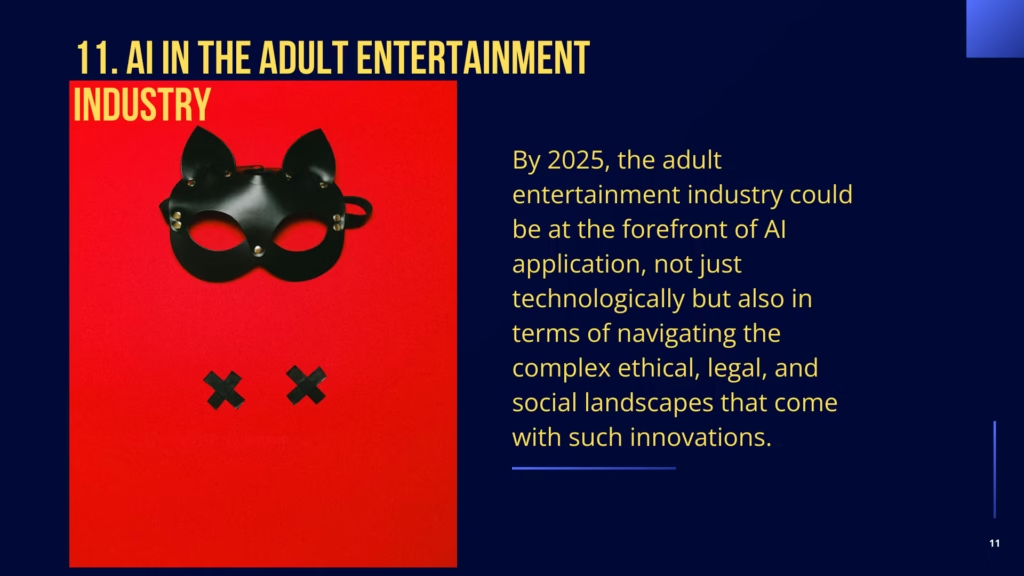
Here’s how this evolution might unfold:
Content Creation
- AI-Generated Content:
AI will be capable of generating hyper-realistic digital content including videos, images, and even interactive scenarios. This could mean personalized content tailored to individual preferences without human performers, using deepfake technology or AI-driven graphics engines. - Virtual Influencers:
AI characters or “virtual influencers” might become stars in their own right, offering fans interactions or content that’s not possible with human actors, all while being customizable to user tastes.
User Interaction
- AI Chatbots:
Advanced AI chatbots, capable of engaging in nuanced, human-like conversations, will offer personalized experiences. These bots could provide companionship, sext, or role-play based on user input, blurring the lines between human and AI interaction. - Virtual Reality (VR) and Augmented Reality (AR):
AI will enhance VR and AR experiences, making them more immersive by adapting in real-time to user reactions or preferences, creating scenarios that feel tailored and spontaneous.
Privacy and Customization
- Privacy Concerns:
With AI’s ability to learn from vast amounts of user data to customize experiences, privacy will be a major concern. Users might demand robust data protection to ensure their preferences and interactions remain confidential. - Custom Experiences:
AI will enable consumers to dictate the specifics of their entertainment, from physical attributes of characters to story arcs, providing a level of personalization previously unattainable.
Ethical and Legal Challenges
- Consent and Deepfakes:
The creation of content featuring likenesses of real people without consent could lead to significant legal and ethical debates. New laws might be needed to regulate the use of someone’s image or likeness in AI-generated content. - Child Protection:
There will be heightened scrutiny on how to prevent AI from being used to generate illegal or harmful content, particularly concerning minors, leading to stricter regulations or tech solutions for content verification and age gating.
Market Dynamics
- Market Disruption:
Traditional adult entertainment companies might see their business models disrupted as AI offers cheaper, scalable content creation. However, this could also open up new markets or niches within the industry. - Revenue Models:
Subscription services, where users pay for AI-generated personalized content or experiences, might become prevalent, alongside ads tailored by AI understanding of user preferences.
Technological Advancements
- Natural Language Processing (NLP):
Advances in NLP will allow for more realistic and engaging interactions, making AI-driven content feel more human-like. - Machine Learning:
Continuous learning from user interactions will refine AI’s ability to predict what content will be popular or appealing, potentially leading to content that evolves with cultural trends.
Societal Impact
- Changing Perceptions:
The normalization of AI in this industry could alter societal views on intimacy, privacy, and the nature of human relationships with technology. - Mental Health Considerations:
There might be increased focus on the psychological effects of engaging with AI for intimate purposes, potentially leading to new areas of research or therapy.
By 2025, the adult entertainment industry could be at the forefront of AI application, not just technologically but also in terms of navigating the complex ethical, legal, and social landscapes that come with such innovations. This sector will likely pioneer new approaches to content creation, privacy, and user engagement, setting precedents for other industries to follow or learn from.
12. Sentient Memes and AI Characters
By 2025, the concept of “sentient memes” and AI-generated characters could become a reality, fundamentally altering the landscape of digital culture, social media, and content creation.
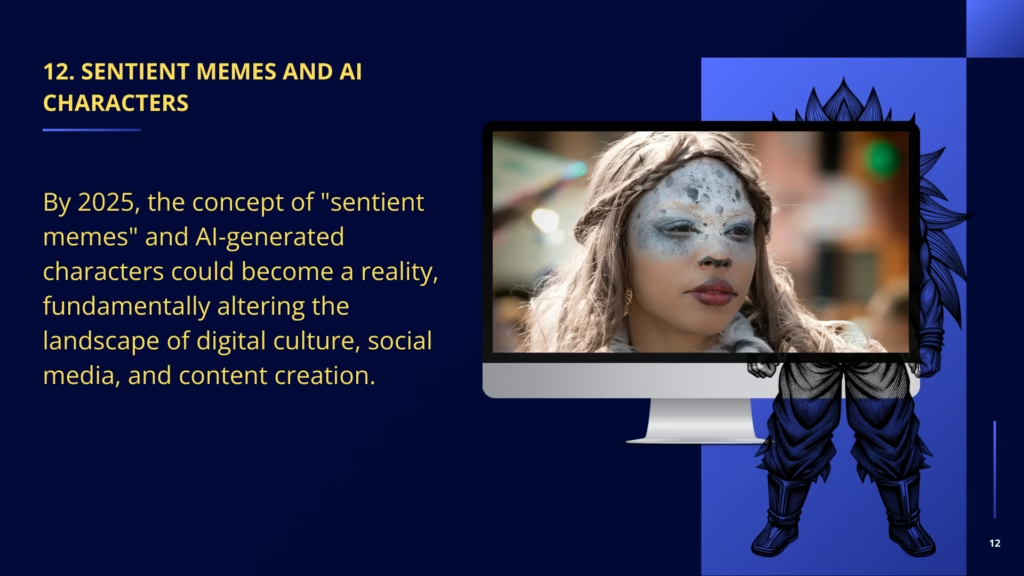
Here’s how this intriguing development might unfold:
Rise of AI-Generated Memes
- Dynamic Content:
AI will be capable of creating memes that evolve in real-time, adapting to current events, trends, or user interactions. These memes could change based on cultural shifts, making them more relevant and engaging. - Sentience Simulation:
While not truly sentient, these AI memes will simulate a level of awareness or reactivity, responding to comments or likes on social media platforms, essentially becoming “alive” in the digital space.
AI Characters as Influencers
- Virtual Influencers:
AI-driven characters will emerge as influencers, with personalities, backstories, and content strategies designed by algorithms to maximize engagement. These characters could endorse products, participate in trends, or even comment on social issues like human influencers. - Interactive Engagement:
These AI entities will interact with users in ways that mimic human conversation, offering personalized responses or even creating content based on user feedback, fostering a sense of connection.
Cultural Impact
- New Forms of Expression:
AI characters and memes could introduce new forms of digital art and expression, where the lines between creator and creation blur. This might lead to new subcultures or online communities centered around these AI figures. - Memes as News:
AI-driven memes might become a primary way for news or information to spread, especially among younger demographics, given their ability to quickly encapsulate complex ideas in humorous or engaging formats.
Marketing and Advertising
- Targeted Advertising:
AI characters can be used for highly targeted marketing, where their actions or messages are tailored to individual user profiles, potentially increasing the effectiveness of advertising campaigns. - Brand Mascots:
Companies might adopt AI characters as brand mascots, which can be updated or adapted in real-time based on consumer feedback or market changes.
Challenges and Considerations
- Authenticity and Trust:
As AI-generated content becomes indistinguishable from human-made, issues of authenticity will arise. There might be a backlash against AI influencers if they’re seen as inauthentic or if they’re used for manipulative purposes. - Ethical Use:
The use of AI in creating content that can influence opinions or behaviors will raise ethical questions. Guidelines might be necessary to prevent misinformation or the manipulation of public sentiment. - Intellectual Property:
Who owns an AI-generated meme or character? This could lead to new legal frameworks around AI-generated content, especially concerning copyright or defamation if AI misrepresents individuals or brands.
Social Dynamics
- Parasocial Relationships:
People might form parasocial relationships with these AI entities, impacting social norms around interaction with technology and potentially affecting real human relationships. - Community Building:
AI characters could also act as moderators or leaders in online communities, using their AI capabilities to manage discussions or promote positive interactions.
Technological Advancements
- Sophisticated NLP and Vision:
Advances in natural language processing and computer vision will allow these AI characters to understand and react to visual and textual content in a nuanced way, making their interactions more believable. - Machine Learning:
Continuous learning from user interactions will make these AI entities smarter over time, adapting not just to content but to the emotional or cultural context of their audience.
By 2025, the integration of AI in meme culture and character creation will likely redefine digital communication, entertainment, and even politics, posing new questions about creativity, identity, and the essence of what makes content compelling or influential in our society.
13. Predictive and Strategic AI Use
By 2025, the application of AI in predictive analytics and strategic decision-making will have matured, fundamentally altering how businesses operate, governments plan, and individuals make life choices.
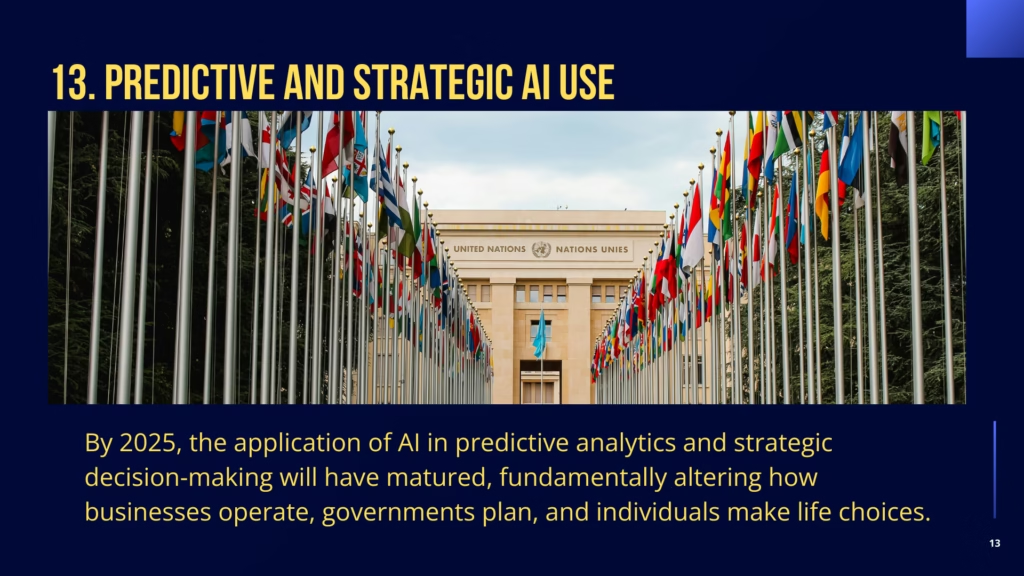
Here’s how AI will enable these changes:
Predictive Analytics in Business
- Market Anticipation:
AI will forecast market trends with unprecedented accuracy, allowing companies to adjust their strategies in real-time. This could mean predicting consumer demand spikes or downturns, enabling businesses to manage inventory, pricing, and marketing more effectively. - Risk Management:
Financial institutions will use AI to predict credit risks, market volatilities, or fraud, leading to more nuanced risk assessment models and potentially reducing financial losses. - Supply Chain Optimization:
AI will predict disruptions, optimize logistics routes, and manage supplier relationships, ensuring supply chains are more resilient against global events.
Strategic Decision-Making
- Scenario Planning:
Corporations will employ AI to simulate different business scenarios based on various strategic moves, providing insights into the outcomes of potential decisions. This will be crucial in sectors like energy, where long-term planning is critical due to infrastructure investments. - Human Resources:
AI can predict employee turnover, assess the impact of HR policies, or recommend the best team compositions for projects, enhancing workforce management and organizational structure.
Government and Public Policy
- Policy Impact Analysis:
Governments will leverage AI to simulate the effects of policy changes, from tax reforms to environmental regulations, allowing for data-driven policy-making that can adapt to real-time feedback. - Public Health:
AI will enhance predictive models for disease outbreaks, resource allocation during crises, or long-term health planning, leading to more proactive public health strategies.
Personal Decision Making
- Life Choices:
Individuals might use AI-powered apps to make decisions about education, career paths, investments, or even health and lifestyle choices, based on predictive models tailored to personal data. - Smart Home Management:
AI will predict and manage household needs, from energy consumption based on weather forecasts to grocery ordering based on consumption patterns.
Challenges and Ethical Considerations
- Data Bias:
The effectiveness of AI in prediction depends on the quality and diversity of data. Biases in data could lead to skewed predictions, necessitating careful data curation and ethical AI practices. - Privacy:
As AI becomes more predictive, the amount of personal data needed grows, raising privacy concerns. There might be pushback or new laws to protect personal information from being used in predictive algorithms.
Technological Advancements
- Advanced Machine Learning:
Techniques like reinforcement learning will evolve, allowing AI to learn from outcomes of past decisions, refining its predictive capabilities. - Integration with IoT:
The Internet of Things (IoT) will provide real-time data, enhancing the precision of AI predictions, particularly in operational contexts like manufacturing or urban planning.
Market Impact
- Competitive Edge:
Companies mastering predictive AI will gain a significant edge, potentially reshaping industries by outpacing competitors in innovation and efficiency. - New Industries:
There could be a rise in new sectors or business models around AI-driven consultancy or services, offering predictive insights as a product.
Cultural Shift
- Decision-Making Paradigm:
There will be a cultural shift towards data-driven decisions, with AI models becoming as consulted as human experts. This might challenge traditional decision-making hierarchies or methods.
By 2025, AI’s role in prediction and strategy will be transformative, not just in terms of efficiency but in how we conceptualize planning and foresight. However, this will require navigating complex ethical landscapes, ensuring data integrity, and fostering public trust in AI-assisted decisions.
14. AI’s Impact on Work Efficiency
By 2025, AI is anticipated to revolutionize work efficiency across various industries, compressing timelines for tasks from months to hours, thereby redefining productivity standards.
Here’s how this transformation might look:
Automation of Repetitive Tasks
- Administrative Work:
AI will automate routine administrative tasks such as data entry, scheduling, or basic customer inquiries, freeing up human resources for more strategic activities. - Manufacturing and Logistics:
In manufacturing, AI-driven robots will handle assembly, quality control, and logistics, reducing human error and speeding up production cycles.
Enhanced Data Processing
- Data Analysis:
AI will drastically shorten the time needed for data analysis, from collecting and cleaning data to deriving insights. Complex analyses that once took weeks could be completed in minutes, aiding decision-making processes. - Financial Reporting:
In finance, AI could generate reports, analyze market trends, and even assist in forecasting, all with minimal human intervention, allowing for quicker, more accurate financial management.
Project Management
- Resource Allocation:
AI tools will predict project outcomes, manage resources more efficiently, and adjust project timelines dynamically based on real-time data, reducing project delays. - Risk Mitigation:
By simulating different project scenarios, AI can identify potential risks early, allowing for proactive adjustments.
Creative Industries
- Design and Content Creation:
AI will assist in generating design options, writing drafts, or even producing music and art, dramatically cutting down the ideation phase. While human creativity remains irreplaceable, AI can accelerate the process of bringing ideas to life. - Marketing:
AI will optimize advertising campaigns by predicting consumer behavior, testing ad variations at scale, and personalizing content, thereby enhancing campaign efficiency and ROI.
Healthcare
- Diagnostics and Treatment Plans:
AI will speed up diagnostic processes by analyzing imaging or lab results, formulating treatment plans, or even predicting patient outcomes, significantly reducing the time from diagnosis to treatment. - Administrative Efficiency:
AI can handle scheduling, patient record management, and even assist in administrative tasks, allowing healthcare providers to focus more on patient care.
Challenges and Considerations
- Workforce Adaptation:
While AI increases efficiency, it also necessitates a shift in job roles, requiring workers to upskill or reskill to work alongside AI systems. - Job Displacement:
There will be concerns about job loss in areas where AI can completely take over, necessitating discussions on retraining, job creation in new AI-related fields, or social safety nets.
Technological Advancements
- Natural Language Processing and Understanding:
Improved NLP will allow AI to interact with humans more naturally, making task delegation and collaboration more seamless. - AI Integration:
AI will be deeply integrated into existing software and systems, becoming an invisible but crucial part of daily operations across sectors.
Cultural Shift in Work
- Redefining Productivity:
There will be a cultural shift towards measuring productivity not just by hours worked but by the value and innovation produced, with AI enabling this focus on outcomes over processes. - Work-Life Balance:
With AI handling more of the grunt work, there might be opportunities for improved work-life balance, though this depends on how organizations choose to implement AI.
Ethical and Social Implications
- Fairness in AI Deployment:
Ensuring AI doesn’t exacerbate inequality or bias in the workplace will be crucial, requiring ethical frameworks for AI application. - Human-AI Collaboration:
The emphasis will be on how humans and AI can work together to enhance human capabilities, not just replace them.
By 2025, AI’s impact on work efficiency will be profound, offering the potential to do more with less, but also challenging us to rethink the structure of work, the nature of jobs, and what it means to be productive in an AI-augmented world.
15. AI and AGI Speculations
By 2025, discussions around Artificial General Intelligence (AGI) are expected to intensify, with both the tech community and the public engaging in more speculative and perhaps optimistic conversations about the possibilities and implications of achieving AGI.
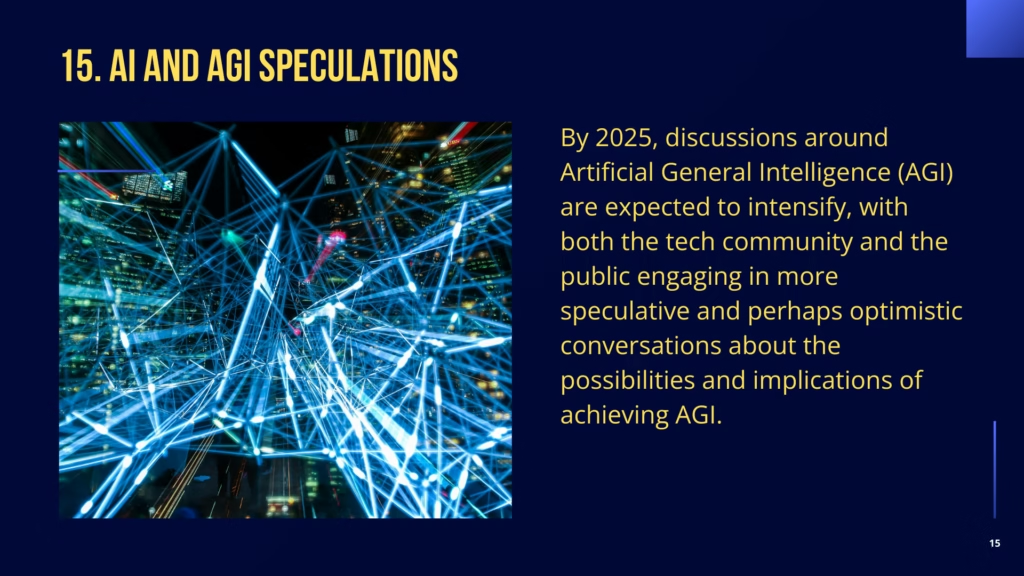
Here’s an exploration of what this might entail:
Understanding AGI:
Definition: AGI refers to an AI system with the ability to understand, learn, and apply intelligence across a wide range of tasks, akin to human cognitive capabilities. This contrasts with narrow AI, which is designed for specific tasks.
Technological Milestones
- Incremental Advances:
While true AGI might still be on the horizon, the steps towards it will be marked by AI systems showing broader, more flexible capabilities.
These might include:
- General Problem Solving: AI demonstrating the ability to tackle new problems it wasn’t explicitly designed for.
- Transfer Learning: AI efficiently using knowledge from one domain in another, showing a semblance of understanding rather than just pattern recognition.
- General Problem Solving: AI demonstrating the ability to tackle new problems it wasn’t explicitly designed for.
Public and Expert Discussions
- Optimism vs. Realism:
There will be a divide between those who optimistically predict AGI around this timeframe and those who caution about the complexities involved, highlighting that AGI is still a long-term goal rather than an imminent reality. - Ethical Debates:
With any progress towards AGI, ethical discussions will ramp up, focusing on rights, consciousness, control, and the societal impact of highly autonomous AI systems.
Potential Applications
- Scientific Research:
An AGI could accelerate scientific discovery by autonomously conducting experiments, developing theories, or solving complex problems in physics, biology, or other fields. - Education:
An AI with general intelligence could serve as an ultimate educational tutor, adapting perfectly to each student’s learning style and pace.
Challenges on the Path to AGI
- Technical Hurdles:
Creating a system that can learn, reason, and apply knowledge across all human tasks involves overcoming challenges in areas like:
- Common Sense Reasoning: AI understanding the world in a nuanced, context-aware manner.
- Creativity and Original Thought: Enabling AI to think beyond its training data.
- Common Sense Reasoning: AI understanding the world in a nuanced, context-aware manner.
- Resource Intensive:
The computational power and data required to train such systems could be immense, raising questions about sustainability and accessibility.
Regulatory and Safety Concerns
- Control and Safety:
The development of AGI will necessitate discussions on how to control such powerful systems, ensuring they align with human values and do not pose existential risks. - Legislation:
Governments might start to draft preliminary regulations or frameworks to govern AGI development, focusing on safety, transparency, and accountability.
Cultural Impact
- Reimagined Work:
If AGI becomes a reality or even if just perceived as close, it could fundamentally change how we think about work, creativity, and human purpose. - Public Perception:
The narrative around AI could shift, with AGI being viewed either as a boon for humanity or a potential threat, influencing public opinion and policy.
Market and Economic Implications
- Innovation Surge:
Companies racing to achieve AGI could lead to a boom in AI-related investments and startups, although the actual economic benefits would depend on how AGI is integrated into society. - Job Market Transformation:
Speculation about AGI would continue to fuel debates on automation and employment, potentially leading to new economic models or social structures.
By 2025, while achieving AGI might still be speculative, the journey towards it will have significantly shaped AI research, public discourse, and perhaps even our collective imagination about the future of intelligence. The focus will be on navigating this path responsibly, balancing between the pursuit of technological advancement and the safeguarding of human values and safety.
Conclusion
As we peer into the future of AI and Machine Learning by 2025, it’s clear that we stand on the brink of a transformative era. From the mainstream adoption of AI agents in our daily lives to the speculative journey towards AGI, the landscape is set for profound changes. AI is poised to become not just a tool for automation but a collaborator in creativity, decision-making, and scientific discovery. Each of the predictions outlined, from multi-modal AI mastery to the potential societal reactions, highlights both the immense potential for innovation and the critical challenges that must be addressed.
The integration of AI into every facet of life will demand new ethical considerations, regulatory frameworks, and societal adaptations. We’ll witness shifts in employment, privacy norms, and even our cultural identities as AI shapes new forms of interaction and content. The promise of increased efficiency, personalized experiences, and groundbreaking scientific advancements comes with the responsibility to manage AI’s development with care, ensuring it benefits all of humanity equitably.
As we approach this future, the dialogue around AI will need to evolve, encompassing not just technical prowess but also the moral, social, and economic implications of such powerful technology. Whether it’s through AI agents managing our daily tasks, robots becoming part of our homes, or AI driving market shifts, the coming years will test our ability to harness AI for the greater good while navigating its complexities. The journey to 2025 in AI and ML will be one of balance between innovation and ethics, technology and humanity, potential and prudence.
Inputs from:
- McKinsey & Company – The State of AI in 2022
- Gartner – Top Strategic Technology Trends for 2023
- Forbes – The Future of AI: Trends to Watch in 2025
- World Economic Forum – How Artificial Intelligence Will Change the World by 2025
- MIT Technology Review – The Future of AI: What to Expect in 2025
- Harvard Business Review – How AI Will Change Work
- Deloitte – AI and the Future of Work
- Accenture – How Artificial Intelligence Will Impact Your Business
- PwC – The Impact of AI on the Future of Work
- Stanford University – AI Index 2021 Report
- Media:
Photo by LJ
Photo by Alexis Caso
Photo by Pixabay
Photo by Google DeepMind
Photo by Pavel Danilyuk
Photo by Edward Jenner
Photo by Pavel Danilyuk
Image by Moondance from Pixabay
Photo by Amine M’siouri
Photo by Anna Shvets
Photo by Mathias Reding
Related article: AI in Enterprise – Revolutionizing Business Operations 2025
Do you have any tip for Contemporary Mahal authors / editors? Please email us contact@contemporarymahal.com